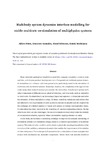Mostrar o rexistro simple do ítem
Multibody system dynamics interface modelling for stable multirate co-simulation of multiphysics systems
| dc.contributor.author | Peiret, Albert | |
| dc.contributor.author | González Varela, Francisco Javier | |
| dc.contributor.author | Kövecses, József | |
| dc.contributor.author | Teichmann, Marek | |
| dc.date.accessioned | 2023-12-22T13:13:12Z | |
| dc.date.available | 2023-12-22T13:13:12Z | |
| dc.date.issued | 2018-09 | |
| dc.identifier.citation | Albert Peiret, Francisco González, József Kövecses, Marek Teichmann, Multibody system dynamics interface modelling for stable multirate co-simulation of multiphysics systems, Mechanism and Machine Theory, Volume 127, 2018, Pages 52-72, https://doi.org/10.1016/j.mechmachtheory.2018.04.016. | es_ES |
| dc.identifier.issn | 1873-3999 | |
| dc.identifier.uri | http://hdl.handle.net/2183/34610 | |
| dc.description.abstract | [Abstract] Many industrial applications benefit from predictive computer simulation to reduce costs and time, and shorten product development cycle. Computational multibody system dynamics formalisms and software tools have proved to be particularly useful in the simulation of machinery and mechanical systems. Nowadays, however, the complexity of the applications under study often makes it necessary to consider the interaction of mechanical systems with other components of different nature, physical behaviour, and time scale, such as hydraulics or electronics. Co-simulation is an increasingly important approach to formulate and solve the dynamics of these multiphysics setups. In these, modelling techniques and solvers that are tailored to the requirements of each subsystem execute in parallel and are coupled via the exchange of a limited number of inputs and outputs at certain communication times. Co-simulation has clear potential in the modelling of complex engineering systems. On the other hand, there are also challenges. The use of co-simulation may compromise the stability of the numerical solution, especially when non-iterative coupling schemes are used. In this work, we introduce a modelling technique to improve the dynamic interfacing of mechanical systems in co-simulation setups, based on a reduced representation of multibody systems. This reduced order model is used to obtain a physically meaningful prediction of the evolution of the multibody subsystem dynamics that enables the improvement of the solution of other subsystems. The technique is illustrated in the co-simulation of some examples that include both mechanical and hydraulic components. Results show that dynamic interfaces based on reduced models can be used to improve the stability of non-iterative co-simulation schemes in multiphysics engineering systems, enabling the use of larger communication stepsizes. | es_ES |
| dc.description.sponsorship | Natural Sciences and Engineering Research Council Canada (NSERC) | es_ES |
| dc.description.sponsorship | CMLabs Simulations, Inc | es_ES |
| dc.language.iso | eng | es_ES |
| dc.publisher | Elsevier | es_ES |
| dc.relation.uri | https://doi.org/10.1016/j.mechmachtheory.2018.04.016 | es_ES |
| dc.rights | Attribution-NonCommercial-NoDerivs 4.0 International | es_ES |
| dc.rights | This is a post-peer-review, pre-copyedit version of an article published in Mechanism and Machine Theory. The final authenticated version is available online at: https://doi.org/10.1016/j.mechmachtheory. 2018.04.016. | es_ES |
| dc.rights.uri | http://creativecommons.org/licenses/by-nc-nd/3.0/es/ | * |
| dc.subject | Co-simulation | es_ES |
| dc.subject | Multibody System Dynamics | es_ES |
| dc.subject | Multirate | es_ES |
| dc.subject | Multiphysics | es_ES |
| dc.subject | Reduced order model | es_ES |
| dc.subject | Co-simulación | es_ES |
| dc.subject | Dinámica de sistemas multicuerpo | es_ES |
| dc.subject | Modelos de orden reducido | es_ES |
| dc.title | Multibody system dynamics interface modelling for stable multirate co-simulation of multiphysics systems | es_ES |
| dc.type | info:eu-repo/semantics/article | es_ES |
| dc.rights.access | info:eu-repo/semantics/openAccess | es_ES |
| UDC.journalTitle | Mechanism and Machine Theory | es_ES |
| UDC.volume | 127 | es_ES |
| UDC.startPage | 52 | es_ES |
| UDC.endPage | 72 | es_ES |
| dc.identifier.doi | 10.1016/j.mechmachtheory.2018.04.016 |
Ficheiros no ítem
Este ítem aparece na(s) seguinte(s) colección(s)
-
LIM - Artigos [51]






